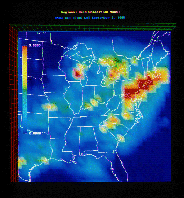|
|
Regional Acid Deposition Model (RADM) AlgorithmThe underlying algorithms for this particular model are complex and varied. A generic "map" of the RADM system is shown in the (large) graphic below. The result of the various forms of RADM are the ambient concentrations of acidic species and the amount or rate of deposition of acidic components.
The following provides a quick overview of each of the above components.
Meteorological modelThe primary meteorological system used in RADM is MM4/MM5. Basically, the met model calculates:
Spatial resolutions for these models is as low as 5 km, with more typical resolutions up to 80 km or more. Temporal (time) resolutions are typically one hour. As you should notice on the large schematic above, the met model can be adjusted to various spatial and temporal resolutions to meet the needs of the modeler.
Emissions inventoriesRADM is designed to accommodate these emissions:
Transport and dispersion componentsSince RADM is a three-dimensional grid model, the modeling space is divided into some number of layers, beginning at the surface and rising to some level in the troposphere. The layers are not necessarily of equal thickness, and the resolutions (spatial and temporal) can be adjusted at various levels. There are a number of assumptions made, such as the fact that horizontal diffusion (along the surface) is typcially ignored since it is contributes only a very small fraction of the overall wind-based transport mechanism.
Gas- and aqueous-phase chemical mechanismsThe RADM chemical mechanism includes about 156 reactions among 63 species. The entire mechanism, showing the reaction and the relevant kinetics rates, can be seen on the the RADM gas-phase chemical mechanism. This mechanism is a lumped mechanism, and makes use of surrogate species such as ALD, which represents all aldehydes with two or more carbon atoms. A lumped mechanism is one in which some number of elementary reactions are joined together as one, thus eliminating some of the faster reactions. For example, reactive organic compounds (ROGs) might be mathematically represented as a "lump" of chemicals based on some constant times the amount in a surrogate, such as KET (which represents ketones):
ROG= The general mechanism for the aqueous-phase chemistry is a series of 22 equilibrium reactions that accommodate transformations between the gas- and aqueous phases, ionization reactions, and oxidation of SO2.
Cloud dynamics algorithmsRADM has a number of algorithms to calculate or approximate the cloud cover for a given simulation run. Clouds are approximated using hourly precipitation, temperature, and relative humidity data, and include approximations of both fair- and poor-weather cumulus and stratus clouds. Perhaps one of the limitations of the RADM model is that there is no transport of clouds from one grid cell to another, and the temporal aspect of cloud formation is held at one hour (in other words, information on clouds is not carried over from one hour of the simulation to the next hour).
Calculations of dry and wet depositionWet deposition is calculated on an hourly basis, with the total amount deposited averaged over each cell of the grid. A sample output is shown below:
 In this graphic, we can see the concentration of wet acid deposition from the Ohio Valley, extending into upstate New York. The red colors represent high levels of acid deposition.
Confused? Have a question? If so, check out the Frequently Asked Questions (FAQ) page or send mail to the OS411 tutor (os411tutor@shodor.org) with your question! Report technical/content problems here |
|
|